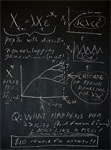
Lord Robert May of Oxford
President of the Royal Society
‘This is a reconstruction, to the best of my memory, of notes and a question (Q) that I put on the blackboard – of almost exactly this size – in the corridor outside my office in the Theoretical Physics Department at Sydney University in 1972. Motivated by problems in ecology, I had been studying some first-order difference equations that entomologists and fisheries people had suggested as rough caricatures of the dynamics of certain populations. Earlier work had focussed on identifying constant, equilibrium solutions (“nature’s balance”) and left it at that. I elucidated the “cascades of period doubling” (and coined this term) as the “boom and bust” of the nonlinear difference equation became more pronounced with increasing population growth rate, λ; as λ increases, the equilibrium solutions for X change from constant to up-down cycles with successive periods 2, 4, 8, 16, … . But I could make no sense of what happened next, beyond the “point of accumulation” of these cycles at λ = 14.77… . Later, in collaboration with Jim Yorke (Maryland), George Oster (Berkeley) and others, I came to understand that beyond lay 1-dimensional “chaos”. This was one of the two strands that brought chaos centre stage in the mid-1970’s, the other strand being Lorenz’s work on 3-dimensional systems of differential equations, where what is going on is inherently harder to understand. Incidentally, 10 Australian dollars in 1972 is more like £50 or more today, although still grossly inadequate for the (unclaimed) reward.
‘For further information, see my chapter in It Must Be Beautiful: Great Equations of Modern Science (ed. G. Farmelo) Granta, London, 2002 or J. Gleick, Chaos: Making a New Science, Viking, New York, 1987.’

